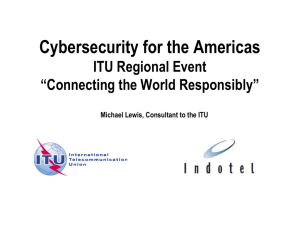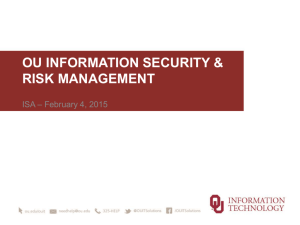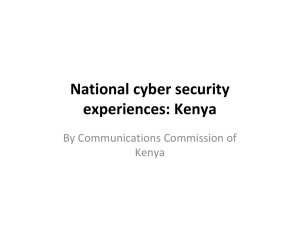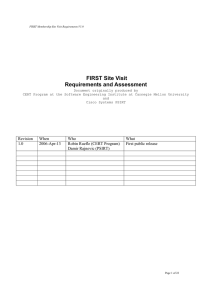Cybersecurity for the Americas ITU Regional Event “Connecting the World Responsibly”
advertisement
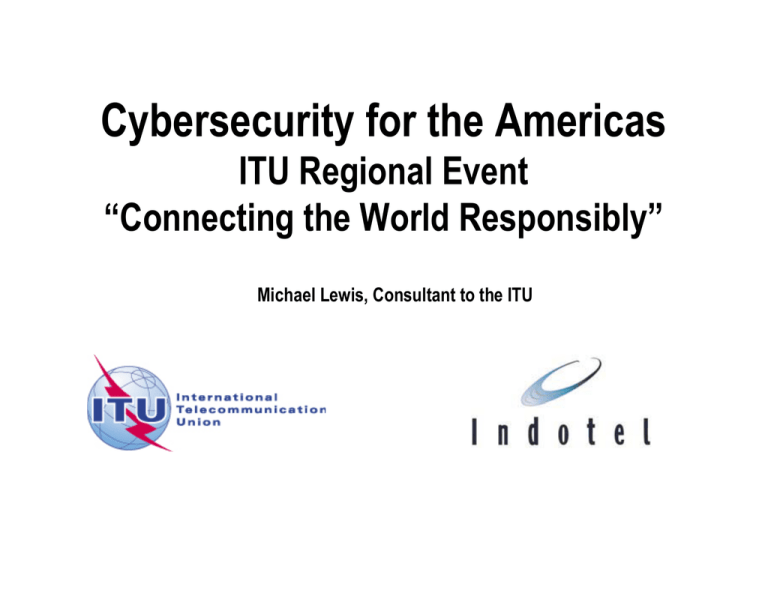
Cybersecurity for the Americas ITU Regional Event “Connecting the World Responsibly” Michael Lewis, Consultant to the ITU 2 General Trends Users on Internet Computers Devices Core Applications ● eGov, CII Vulnerabilities Exploits Financial Incentives Criminal Activity & consider political motivations! 3 The Dynamics of CyberCrime Barriers to entry are minimal resources are essentially free (!) ● technical requirements are modest ● Low risk, high reward! Opportunities grow with continued E-volution of services ● Returns are tantalizingly large ● Physical distance of criminal from the “scene” of the crime renders apprehension unlikely ● Prosecution is rare Investigation is costly in time & resources ● Challenging to trace and attribute ● Coordination of investigations across borders is difficult ● Innovation seems to be more prevalent on the “dark” side – consider botnets! Cybercrime is a growth industry! 4 Considerations for the Workshop We are all doing something (because we have to!) but how well is it working? Is there a national strategy for cyber security, with policies, and operational capabilities? If so, is it coherent and compliant (?) ? So many actors – How do we establish authority, roles, responsibilities, and coordination? So much data, and so many organizations - How and where to link and assimilate? When something goes wrong, who do you call? 5 Coordinating a National Approach to Cybersecurity Develop a national cybersecurity strategy and policies ● For each actor, identify constituents and services ● What do you do, and for whom? Are there gaps? Redundancies? Build trusted relations & secure mechanisms for collaboration with counterparts (national, regional, international) ● It starts with a self-assessment of the current state of affairs In advance, not in times of crisis Establish relevant operational capabilities – such as Incident Management & Coordination Conduct regular, targeted events to build skills, test systems and escalation procedures, & share experience The work should be subject to ongoing self-assessment and course correction. 6 Computer Security Incident Response Team (CSIRT) As many have noted, a “CSIRT” is one component of a national cyber security strategy ● ● ● ● aka, a Computer Emergency Response Team” aka, a Computer Incident Response Team aka, a Computer Incident Readiness Team Or, any number of variations! Can exist within an organization, or at a national, regional, or global level ● Actually, at all levels, mutually reinforcing Should be proactive more than reactive ● Note the reactive implications of most of the acronyms! 7 Why Build a CERT / CSIRT / CIRT? Cyber Security is important enough to receive dedicated personnel and resources ● Rather than “oh, and you guys should do security, too” It can exemplify and propagate high-level policies and best practices It can formalize incident response and capture “lessonslearned” to improve policies and procedures It establishes responsibility, accountability, “accredited” points-of-contact, and reliable communication channels Sort of a “Ghostbusters” for cyber incidents 8 Range of Services as per the SEI of CMU Any given CSIRT is likely to implement only a subset of such services 9 An Organizational CSIRT Who do they call? end-user “first responder” Help Desk IT Department Network Ops • • • • • • Push Alerts, Updates, Patches Propagate and Enforce Policies Receive Reports Respond to Incidents! Observe Escalation Procedures Report as needed to national center “Front-Line” Response to formalize “internal” incident response Note the “Forum of Incident Response and Security Teams” 10 National CSIRT Bank CSIRT Ministry CSIRT Oil co. CSIRT Organizational CSIRT • Identify Points-of-Contact • Exchange Encryption Keys • Establish NDAs & MoUs Organizational CSIRT National Coordination Center Government CSIRT Sector-specific CSIRT ISP CSIRT • • • • Scope-of-Service Incident Coordination & Reporting Incident Analysis & Forensics Outreach, Awareness, & Training Critical Infrastructure Protection A necessary but not sufficient component of a national cyber security strategy Note the “CSIRTs with National Responsibility” working group 11 National CSIRT Activities representative examples from recent work Launched an Outreach, Awareness, and Training group ● ● ● ● Conducted dozens of specialized trainings and workshops Worked with schools and universities to provide security material, lectures, and even shape course curricula Established a cyber-security forum series Hosted quarterly regional and international security events, such as an ITU regional workshop, a FIRST Technical Colloquium, and the inaugural Regional-CERT meetings 12 National CSIRT Activities representative examples from recent work (2) Launched the national incident reporting and response center ● ● ● ● ● ● Inaugurated national incident reporting and response Encouraged the creation and ongoing support of organizational CSIRTs, with mutual p-o-c’s, key exchange, workshops Built a state-of-the-art cyber-forensics lab Provided training in policy and practice for national law enforcement Conducted “incident response and engagement with law enforcement” program for constituents Provided 24/7 technical back-stopping for high-profile national events 13 National CSIRT Activities representative examples from recent work (3) Established a Critical Infrastructure Protection group and “sector working groups” ● and helped draft the national CIIP policy ● to identify and propagate high-level practices, procedures, and compliance methods ● 14 The Cyber Security Network organizational CSIRTs end users External organizations The CSN National CSIRT FIRST IMPACT ITU Law Enforcement Regional Organizations At each level, organizations have relations with external partners and professional societies A community with complementary and reinforcing roles and responsibilities, from end-user up to the national level 15 Align & Partner many good initiatives exist 16 Further Discussion Points Scaling of points-of-contact relations Confidence and discretion of national CERTs Incident Response vs. Cyber Forensics Incident Response & issues of authority, responsibility, liability, coordination ● ● ● Ex. - “Takedown” Ex. - Denial of Service Ex. - Financial Fraud & balancing interests of law enforcement vs. that of various victims 17

